A Guide to the Slalom Rules
Feedback is welcome - send it to .
The Aim of Canoe Slalom
The aim of canoe slalom is to run a rapid river course marked by "gates" fast, and without touching.
A "gate" is two poles, suspended over the water. Green and white gates are negotiated in a downstream direction, red and white gates upstream.
The competitor has to pass through all the gates in number order, and in the right direction - red ones upstream, green ones downstream.
The gates are numbered in the order of negotiation on yellow panels with black numbers. On the side of the gate opposite to the direction of negotiation a diagonal red line crosses through the number.
If the paddler touches a pole with anything - paddle, boat, buoyancy aid, helmet or any part of the body - a 2 second penalty is added to his/her time. If a gate is missed out, or negotiated in the wrong direction or upside down, the penalty is 50 seconds.
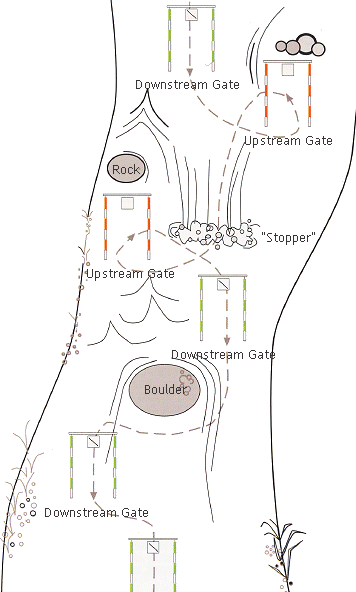
The Gate Line
The gate line is the space between two vertical lines drawn from the outside edges of the bottoms of the two poles to the river bed. If the poles are displaced by a competitor, wind or water, the gate line moves with them.
A paddler at X is inside the gate line
A paddler at Y is outside the gate line
A paddler at Z is inside the gate line
Note: the definition "...to the river bed" makes it clear that, for example, a paddler who has passed through the gate upside-down has started negotiation and any previous gates not negotiated are "dead".
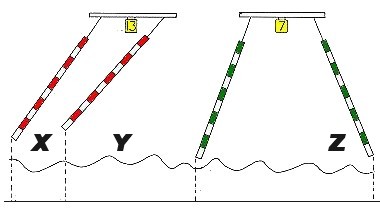
Much of the judging exam is based on diagrams similar to those used here, and candidates may find it helpful to get used to them.
The direction of the current is
![]() (up the page) in all the
diagrams below.
(up the page) in all the
diagrams below.
Correct Negotiation
A faultless negotiation is achieved when the boat (or part of it) and at least the whole head of the paddler cross the gate line in the correct direction at the same time, and no part of the boat, the paddler or his equipment touch either pole. For C2s, both paddlers' heads must cross the gate line in one continuous movement.
Score 0 (clear) for Gate 2 in all the next four diagrams.
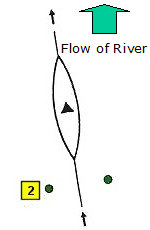
| Gate | Penalty | Reason |
| 2 | 0 |
Passing through the gate sideways or backwards is acceptable as long as the direction of travel is right.
The ends of the boat can pass under the ends of the poles, as long as they don't touch them.
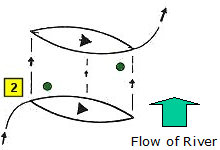
(sideways)
| Gate | Penalty | Reason |
| 2 | 0 |
Passing through the gate sideways or backwards is acceptable as long as the direction of travel is right.
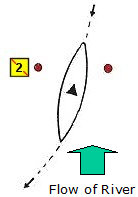
(backwards)
| Gate | Penalty | Reason |
| 2 | 0 |
Part of the boat, and even the paddler's body, can enter and reverse out of the gate without penalty, provided that the paddler's head does not enter the gate line and the paddler subsequently negotiates the gate correctly.
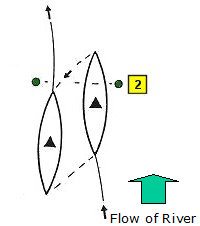
| Gate | Penalty | Reason |
| 2 | 0 |
Touch Penalty
Score a 2-second penalty when the competitor negotiates the gate correctly but any part of the paddler, boat, paddle or personal equipment touches either pole.
Touching a pole twice, or touching both poles, does not increase the penalty. In your notes, write down the first touch - which pole, and what touched it.
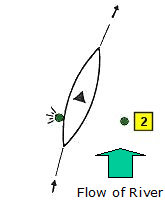
| Gate | Penalty | Reason |
| 2 | 2 | side of boat, left pole |
Incorrect Negotiation / Gate Not Negotiated
Note: if a paddler or C2 crew would have incurred a 50 penalty by missing a gate, "no boat", not the whole head, being capsized through the gate line or, in the case of a C2, when only one of the two paddlers has passed through the gate ("split gate"), the paddler/crew can return and make a second attempt at the gate and "clear" the 50 provided that they did not pass through the gate line in the wrong direction and they have not touched or negotiated a following gate.
The second attempt must be a correct negotiation in its own right. In a C2, both paddlers' heads must pass through the gate on the second pass - if the crew have "split" the gate it is not sufficient just to get the other paddler through.
It is always the last passage that counts: if you go through a gate once correctly but then go round and pass through the gate again, and in doing so you half head it or capsize in it, a 50 applies - unless you do it yet again.
Any touch penalty stands, whether incurred on the first or second attempt.
Score a 50-second penalty when:
The competitor passes through the gate in the wrong direction - with or without a touch.
It is not a penalty if there is a movement in the wrong direction - a wash back, a bounce off a rock or the wind moving the gate back and forward - provided that the paddler is going in the right direction at the start and finish of negotiation.
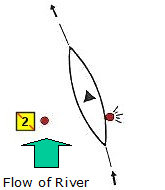
| Gate | Penalty | Reason |
| 2 | 50 | wrong way |
The boat and the paddler's head do not pass though the gate - but the paddler can return, negotiate the gate and "clear" the penalty provided they have not touched or negotiated a following gate.
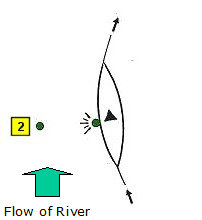
| Gate | Penalty | Reason |
| 2 | 50 | out of gate right |
The whole of the paddler's head does not pass through the gate line - but the paddler can return, negotiate the gate and "clear" the penalty provided they have not touched or negotiated a following gate.
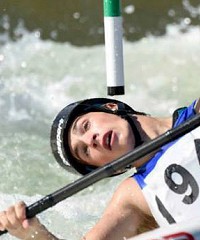
Photo stolen from the judging
guide produced by Canoe Slalom New Zealand
| Gate | Penalty | Reason |
| 2 | 50 | only half head |
There is no part of the boat in the gate when the paddler's head passes through - but the paddler can return, negotiate the gate and "clear" the penalty provided they have not touched or negotiated a following gate.
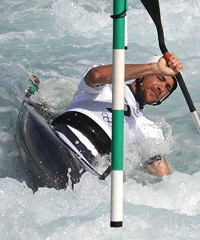
Photo stolen from the judging
guide produced by Canoe Slalom New Zealand
| Gate | Penalty | Reason |
| 2 | 50 | no boat |
In the case of a C2, the boat leaves the gate line without both paddlers' heads passing through - but the pair can return, negotiate the gate and "clear" the penalty provided they have not touched or negotiated a following gate.
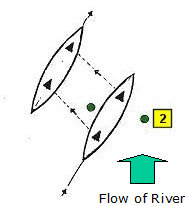
| Gate | Penalty | Reason |
| 2 | 50 | back man not through gate line |
The boat is upside-down in the gate line - but the paddler can return, negotiate the gate and "clear" the penalty provided they have not touched or negotiated a following gate.
Note: it is not considered "upside down" if part of the paddler's head is above the water.
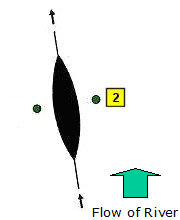
| Gate | Penalty | Reason |
| 2 | 50 | upside-down in gateline |
"Pre-Touch" and "Pre-Negotiation"
Once a paddler negotiates any gate - or even touches it - all previous gates are "dead". If any previous gate has not yet been negotiated a 50-second penalty applies even if the paddler afterwards negotiates it.
However, the paddler can paddle through "dead" gates in either direction or even touch the poles without further penalty.
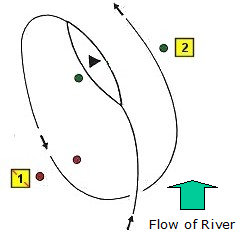
Here the paddler passes through Gate 2 before negotiating Gate 1. Gate 1 is "dead" before the paddler negotiates it - but the second passage through Gate 2 does not incur any penalty.
| Gate | Penalty | Reason |
| 1 | 50 | pre-negotiation of Gate 2 |
| 2 | 0 |
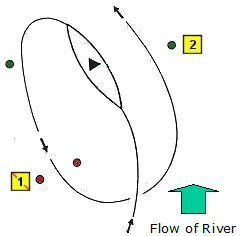
Here the paddler crosses a wide Gate 2 gate line and turns back across the line to negotiate Gate 1.
Gate 1 is "dead" before the paddler negotiates it, so a 50 is incurred. But although the paddler came back through Gate 2, there is no penalty on Gate 2 because negotiation started and finished in the correct direction.
| Gate | Penalty | Reason |
| 1 | 50 | pre-negotiation of Gate 2 |
| 2 | 0 | (negotiation started and finished in correct direction) |
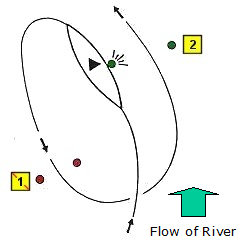
Here the boat touches the outside of the right pole of Gate 2 before negotiating Gate 1. Although the paddler goes on to negotiate Gate 1 it is already "dead".
| Gate | Penalty | Reason |
| 1 | 50 | pre-touch on Gate 2 |
| 2 | 2 | boat, outside touch left pole |
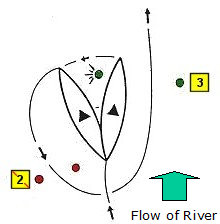
Here the nose of the boat enters Gate 3 and, in turning away, touches the tip of the pole with the foredeck.
If the front of the boat had passed under the Gate 3 pole without touching, there would be no penalty on either gate.
| Gate | Penalty | Reason |
| 2 | 50 | pre-touch on Gate 3 |
| 3 | 2 | foredeck, left pole |
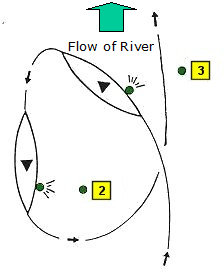
Here the paddler touches Gate 3. Gate 2 is now "dead", so the outside touch doesn't matter. There is no additional penalty for the touch on Gate 2, or for not negotiating it.
| Gate | Penalty | Reason |
| 2 | 50 | pre-touch on Gate 3 |
| 3 | 2 | boat, outside touch left pole |
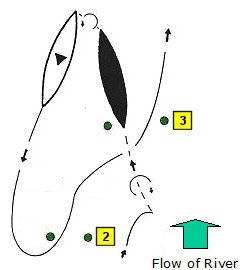
Even if the boat is upside-down when it passes through a gate, it counts as a negotiation. Here the boat passes though Gate 3 upside-down (represented by the black boat) then rolls up. Gate 2 is "dead" before the paddler negotiates it.
The later correct negotiation of gate 3 "clears" that penalty, but the 50 on gate 2 stands.
| Gate | Penalty | Reason |
| 2 | 50 | pre-negotiation of Gate 3 |
| 3 | 50 0 | upside-down in gate line cleared |
When it's not a 50
If the paddler's head crosses the gate line in the wrong direction...
It is not a penalty if there is a movement in the wrong direction, as long as you start and finish in the right direction
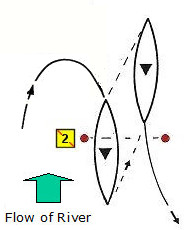
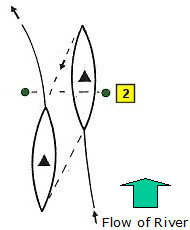
If one of the two heads in a C2 crosses the gate line in the wrong direction..
It is not a penalty if there is a movement in the wrong direction, as long as you start and finish in the right direction
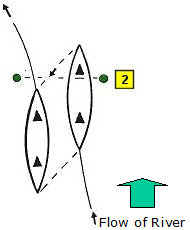
If the paddler repeats a gate...
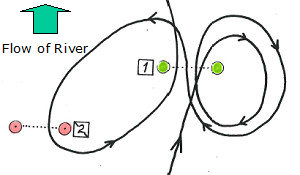
In this diagram the paddler does Gate 1 three times, then does Gate 2, and then goes through Gate 1 again. But there's no penalty.
You can do a gate as many times as you like, as long as it's in the right direction - but the gate is "live" and any touch, on any pass, will count. Once your head enters Gate 2, or you touch it, Gate 1 is "dead" and going through it - even in the wrong direction, or even touching it - isn't a penalty.
Even if...
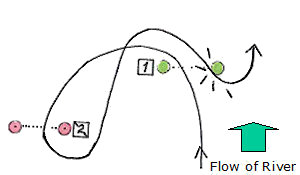
Even if, after doing Gate 2, the paddler goes through Gate 1 in the wrong direction, and/or with a touch, there is no penalty because the gate is "dead".
If the paddler is capsized though a gate but...
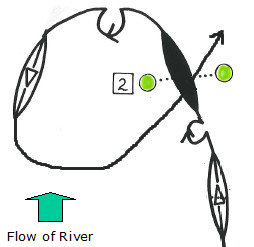
The paddler passes through Gate 2 capsized. That would be a 50, but the paddler rolls up and negotiates Gate 2 again, right side up. There's no penalty - but see right!
If the bottom of the boat had touched a pole while capsized, a 2-second penalty would apply.
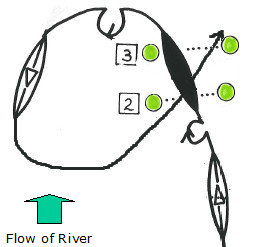
BUT if the capsized boat passed through two gates, the second attempt clears the second gate (Gate 3) but not Gate 2, because passing through Gate 3 capsized counts as starting negotiation of Gate 3 and "kills" Gate 2.
Catch-ups and "Whistling Off"
If a paddler catches up with the one ahead, he/she has right of way and the paddler ahead should pull out of the way until the faster paddler has gone through. The judge should "whistle off" the paddler being overtaken, and the overtaken paddler must then get out of the way until the faster paddler is clear. If he/she does not, the judge should ask the jury to consider a disqualification. If the faster paddler is obstructed the judge should record what happened and ask Control to advise the jury that the paddler should be given a re-run if he/she asks for it.
Wait before you whistle. Whistle off only when the paddler ahead will obstruct the one behind. Don't whistle off one paddler just because both boats are in your section and it's difficult for you to cope.
You should not whistle a paddler off if the paddler behind has missed several gates. It can be difficult to know, since this was probably out of your sight. If judges higher up the course are on the same communications line as you they may be able to warn you, but it is still difficult to make a fair call.
Section Judging, and Gate Judging with Section Judges
If you are working with a section judge, you judge and keep a note of the penalties, and the reasons for them, just as you would working alone. But you signal your decisions to the section judge with:
• A red bat or and open hand with the fingers upwards and spread for a 50
• A yellow bat or your hand with one finger raised for a 2
• A sweep of the hand for "clear".
If the gates are widely spaced you might do this gate by gate, but usually you’ll watch a paddler through your section and then signal.
• If the paddler is clear on all gates in the section, one wide sweep of your hand is enough
• If (say) it’s clear on the first gate, a touch on the second, clear on the third and 50 on the fourth, signal: sweep, yellow bat/finger, sweep, red bat/open hand
The section judge should signal back to you exactly what you signalled. It doesn’t mean that he/she agrees, it’s just confirming what you said.
The Rules
Below are the gate negotiation rules according to the rulebook.
10.6 Negotiation
10.6.1 All the gates must be negotiated in numerical order.
10.6.2 All gates may be negotiated in any presentation from the correct side of the gate as displayed by the gate number panels.
10.6.3 The gate line, in all circumstances is defined as the line between the outside edge of the bottom of the two poles, projected from the end of the poles vertically to the river bed.
10.6.4 The following conditions must be satisfied for negotiation of the gate:
Negotiation of a gate begins when the boat or the body or the paddle touches a pole of the gate or part of the head of a athlete (in C2, one of the two athletes) breaks the gate line.
Negotiation of a gate is ended when the negotiation of any subsequent gate begins or the finish line is crossed.
10.6.5 The following conditions must be satisfied for a gate to be considered correctly negotiated:
10.6.5.a The whole head of the athlete or athletes must cross the gate line in accordance with the correct side of the gate and the course plan.
UK In the case of C2 the heads of the two athletes must cross the line in a single continuous passage (without the boat leaving the gate line).
10.6.5.b Part of the boat must cross the gate line at the same instant as the complete head crosses the line.
10.7 Zero (0) Penalty Seconds
10.7.1 Correct negotiation without touching the pole with any part of the body, equipment, paddle or boat.
10.8 Two (2) Penalty seconds
10.8.1 Correct negotiation of the gate, but with a touch of one or both poles.
10.8.2 Repeated touching of the same or both poles is only penalised once.
10.9 Fifty (50) Penalty seconds
10.9.1 Touch of a gate (either 1 or 2 poles) without correct negotiation of the gate.
10.9.2 Intentional pushing of a gate to allow
negotiation. The criteria to judge an intentional push are:-
• The athlete is not in a position in to negotiate the gate, or
• That an unexpected action of the
athlete (stroke or body
motion) enables negotiation of the gate.
10.9.3 The head of the athlete (in C2 one or both athletes) breaks the gate line upside down (for definition of upside down see Rule C32.1) unless correctly renegotiated before any subsequent gate negotiation begins.
10.9.4 Any part of the head of the athlete breaks the gate line in the wrong direction during negotiation of the gate, unless the negotiation of the gate begins in the correct direction and finishes in the correct direction before any subsequent gate is negotiated.
10.9.5 Gate left out: Gate(s) left out is determined to have occurred when negotiation of any subsequent gate begins or the finish line is crossed.
10.9.6 The last team member failing to cross the finish line within fifteen (15) seconds of the first team member to finish.
10.9.7 Part of the head breaks the gate line (in C2, one or both athletes) in the correct direction, with or without part of the boat, unless correctly renegotiated before any subsequent gate is negotiated.
10.10 Undercutting of a gate
Undercutting of a gate by the athlete with any part of body or equipment, except part of their head, without a touch is not penalised.
10.11 Repeated attempts at a gate
Repeated attempts at a gate without touching the poles is not penalised if part of the head of the athlete(s) has not broken the gate line in the wrong direction.
10.12 Maximum Penalty for a Gate
Fifty (50) penalty seconds is the maximum obtainable by any one athlete on any gate.
10.13 Benefit of any Doubt
At all times, the benefit of any doubt must be given to the athlete.
